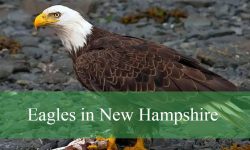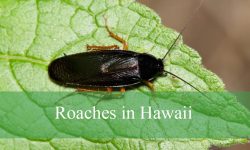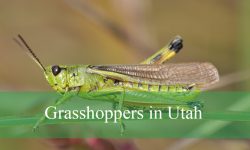Gray birds are some of the most common and interesting birds found in Mississippi. They come in many sizes and shapes, from small songbirds to larger birds of prey. Their soft gray colors help them blend into a variety of environments across the state.
This guide introduces 20 different gray bird species that live in or migrate through Mississippi. Each bird is described with clear pictures, unique features, behaviors, and habitat preferences to make identification easier.
Birdwatchers and nature lovers can use this list to learn more about the gray birds around them. It is a simple way to discover the beauty and diversity of Mississippi’s birdlife.
Common Gray Birds Found in Mississippi
Northern Mockingbird (Mimus polyglottos)
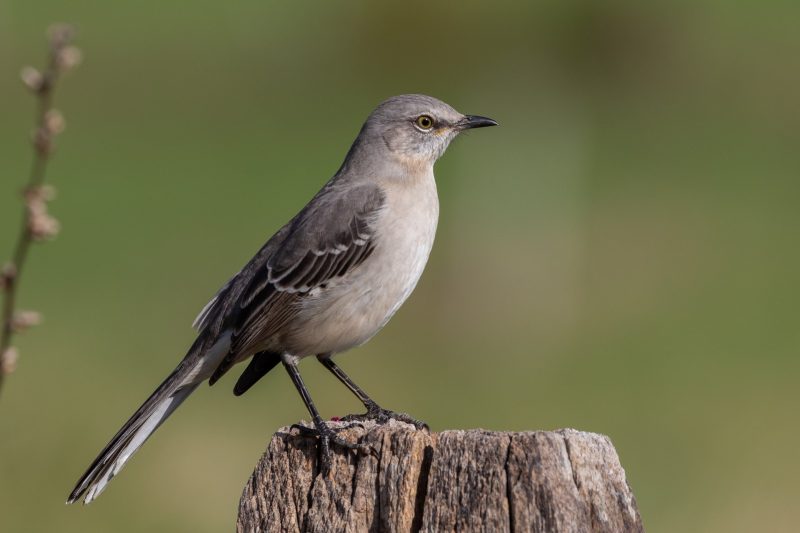
The Northern Mockingbird is a medium-sized songbird with light gray upperparts and a paler belly. It shows bold white patches on its wings and outer tail feathers, which are easily seen in flight or when it flashes them during foraging. It measures about 9 to 11 inches long and has a slim build with a slightly curved bill.
Famous for its vocal abilities, this bird can mimic the songs of dozens of other species, as well as mechanical sounds. It often sings loudly from rooftops, utility lines, or tree branches, especially during the breeding season. Both males and females are territorial and will aggressively defend their nesting areas.
In Mississippi, the Northern Mockingbird is widespread and commonly found in towns, suburbs, and open parks. It prefers areas with low shrubs or trees and open ground for feeding. This adaptable species is a year-round resident throughout the state.
Tufted Titmouse (Baeolophus bicolor)
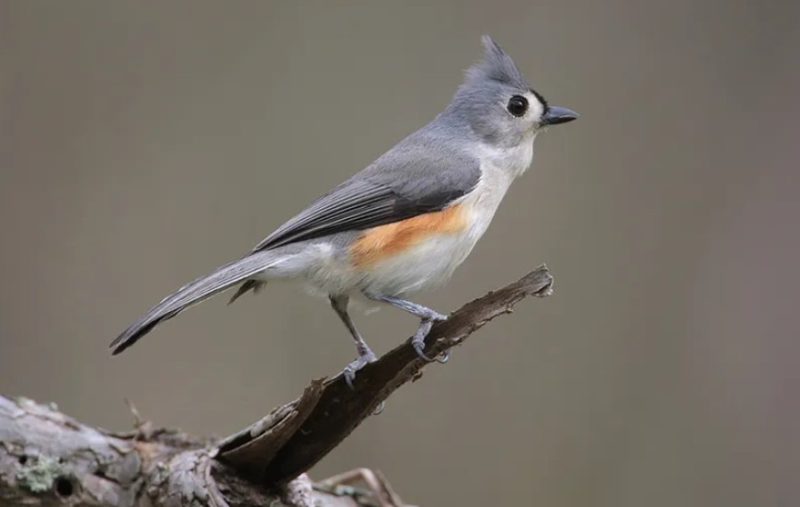
The Tufted Titmouse is a small gray songbird with a noticeable crest on its head, a black patch on the forehead, and soft rust-colored flanks. Its back and wings are pale gray, while the underside is whitish. It typically measures between 5.5 and 6.3 inches in length and has a compact, rounded shape.
These birds are lively, curious, and often seen flitting through tree branches or hanging upside down while foraging. They frequently visit bird feeders, especially those offering sunflower seeds or suet. Their clear, whistled call “peter-peter-peter” is a familiar sound in wooded neighborhoods.
Tufted Titmice are year-round residents across Mississippi. They thrive in deciduous woodlands, forest edges, and mature suburban yards. They often nest in tree cavities or nest boxes during spring.
Blue-gray Gnatcatcher (Polioptila caerulea)
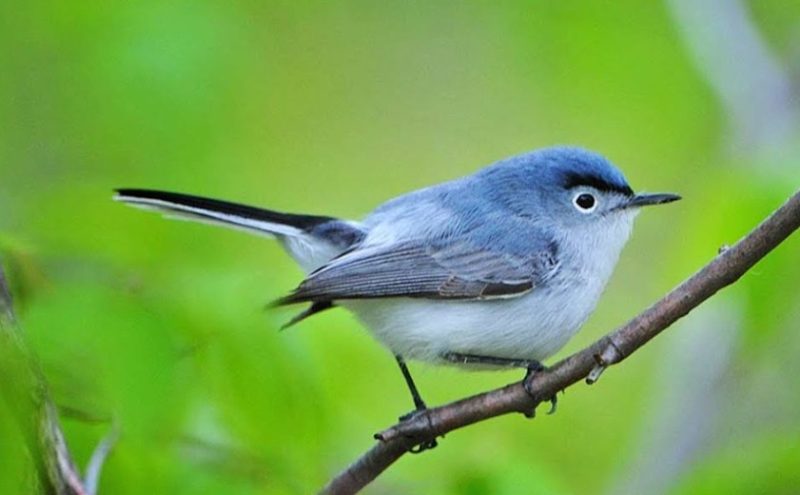
The Blue-gray Gnatcatcher is a tiny, active songbird with bluish-gray upperparts, a whitish underside, and a long, narrow tail edged in white. It measures only 4 to 5 inches long and has a thin, pointed bill. During the breeding season, males may show a faint black “eyebrow” above the eye.
This bird is constantly on the move, flicking its tail from side to side and gleaning small insects from leaves and branches. Its movements are quick and darting, making it appear restless. The call is a soft, nasal “spee” that’s easy to overlook unless you’re paying attention.
In Mississippi, Blue-gray Gnatcatchers are common in spring and summer. They nest in woodlands, especially near streams or swampy edges, and are also found in wooded parks and gardens. They migrate southward in the fall.
Eastern Phoebe (Sayornis phoebe)
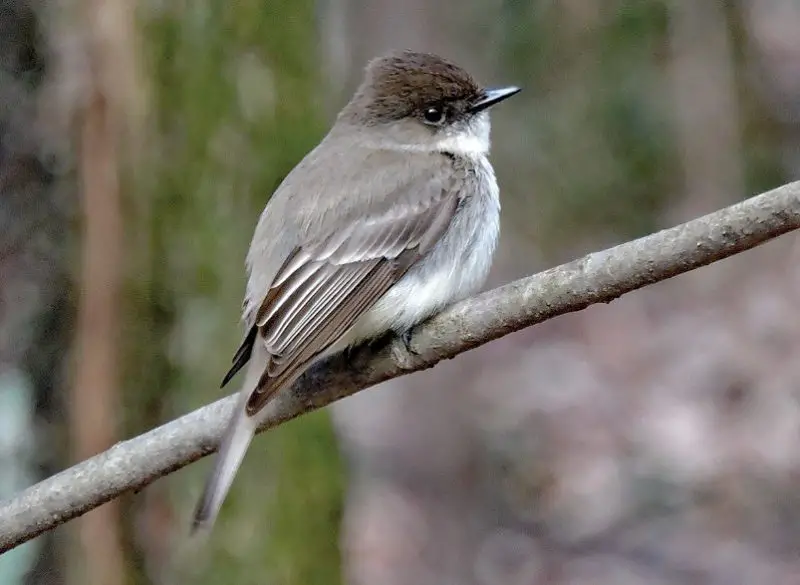
The Eastern Phoebe is a small flycatcher with grayish-brown upperparts, a pale belly, and a slightly darker head. It lacks wing bars and a bold eye ring, giving it a plain look. It measures about 6 to 7 inches long and has a medium-length tail that it often bobs up and down.
This bird is known for its tail-wagging behavior and its simple two-note “fee-bee” song, which it repeats frequently. Eastern Phoebes are often seen perched quietly on low branches, wires, or fence posts, flying out to snatch insects from the air before returning to the same spot.
In Mississippi, they are commonly found near wooded streams, shaded creeks, and under bridges. They build their nests on man-made structures like eaves, culverts, and ledges, using mud and moss. Eastern Phoebes arrive in early spring and are among the first flycatchers to return.
Loggerhead Shrike (Lanius ludovicianus)
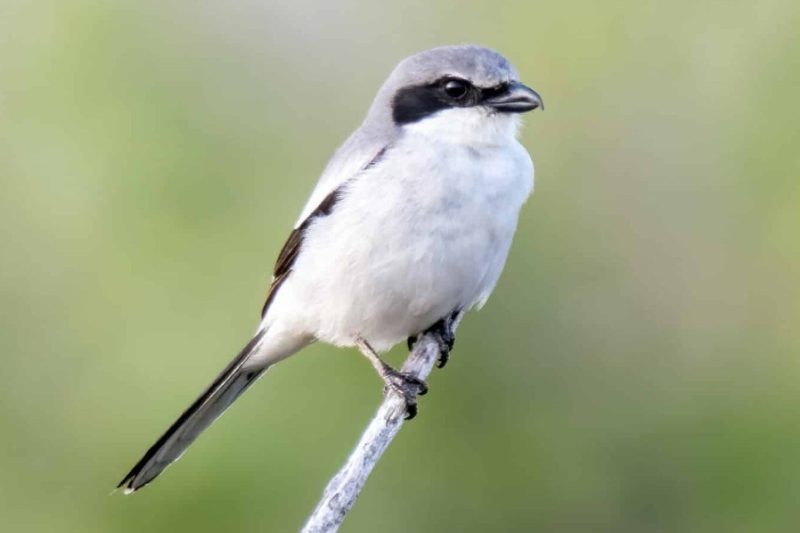
The Loggerhead Shrike is a medium-sized songbird with a pale gray body, white underparts, a black mask through the eyes, and black wings with white patches. It has a heavy, hooked bill more typical of a raptor than a songbird. Adults measure about 8 to 9 inches in length.
This species is unique among songbirds for its predatory habits. Loggerhead Shrikes feed on insects, lizards, and even small mammals and birds. They’re known for impaling prey on thorns or barbed wire to store food or help tear it apart. From perches, they scan fields and then swoop down to grab prey.
In Mississippi, Loggerhead Shrikes inhabit open countryside, farmland, pastures, and grassy roadsides. They favor areas with scattered shrubs, fence lines, and short trees. Although still present, their populations have declined in some regions due to habitat loss and pesticide use.
Gray Catbird (Dumetella carolinensis)
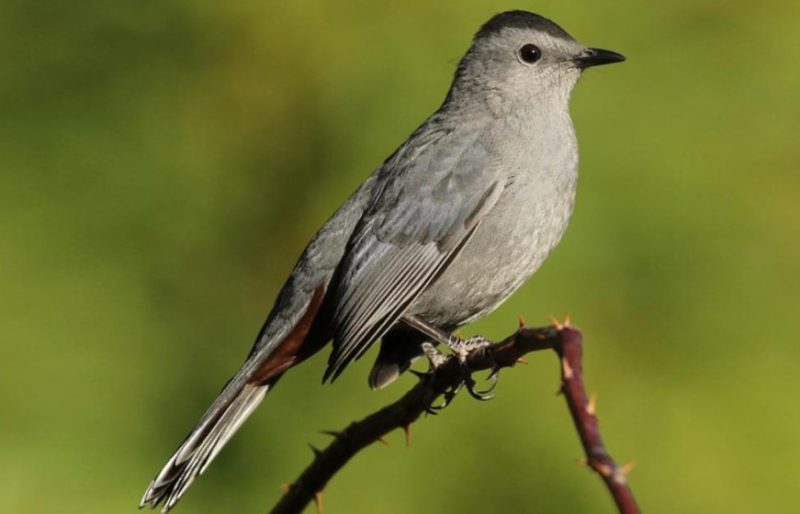
The Gray Catbird is a medium-sized songbird with smooth slate-gray plumage all over, a distinctive black cap, and a rich chestnut patch under the tail. It measures about 8 to 9 inches long and has a thin, straight black bill. Its long tail is often held down or flicked slightly.
This bird is best known for its cat-like mewing call, but it also mimics other birds and sounds with an impressive range of notes. Gray Catbirds are often secretive, staying low in dense shrubs, but they will sing boldly from exposed perches during breeding season.
In Mississippi, Gray Catbirds are summer residents, favoring thickets, forest edges, overgrown fields, and residential hedgerows. They nest in dense vegetation and are most active during spring and early summer, when their varied songs can be heard across woodlands and gardens.
Mississippi Kite (Ictinia mississippiensis)
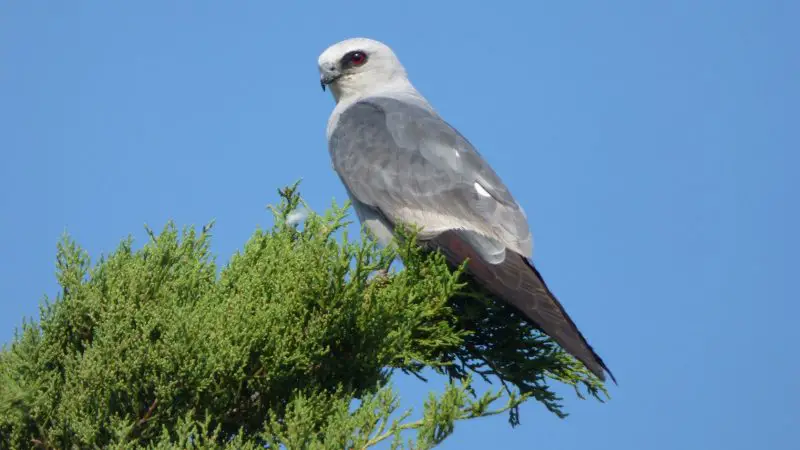
The Mississippi Kite is a slender, graceful raptor with a smooth gray body, darker wings, and pale head. It has long, pointed wings and a lightly forked tail, measuring about 12 to 15 inches in length. In flight, its buoyant and acrobatic movements make it unmistakable.
Unlike most raptors, Mississippi Kites feed mainly on large insects such as cicadas, dragonflies, and grasshoppers, which they often catch in midair. They are social birds and can be seen soaring in small groups over fields, especially in the late afternoon.
This species is a summer breeder in Mississippi, found in open woodlands, agricultural areas, and along river corridors. They nest in tall trees, sometimes near neighborhoods, and return each spring from wintering grounds in South America.
Northern Rough-winged Swallow (Stelgidopteryx serripennis)
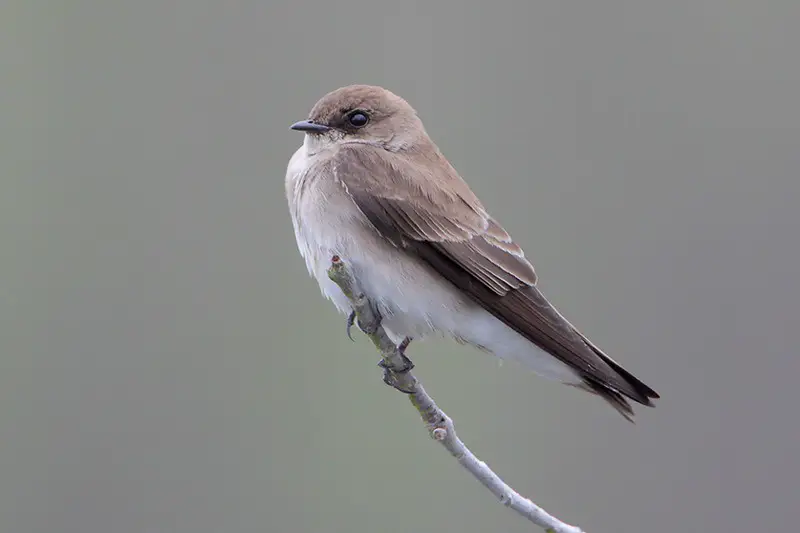
The Northern Rough-winged Swallow is a small, brownish-gray bird with a plain appearance, lacking the vivid colors of some other swallows. Its upperparts are dull gray-brown, with slightly paler underparts, and it has a short, squared tail. It measures about 5 to 6 inches in length.
These swallows are fast, agile flyers that feed on flying insects over water and open ground. They often fly low, skimming just above the surface of rivers, lakes, or ponds. The name “rough-winged” comes from small hooks on the leading edge of their primary feathers, though this feature is not visible in the field.
In Mississippi, they nest in burrows along stream banks, drainage pipes, and crevices in buildings or bridges. They are typically seen in spring and summer, often around waterways or near human structures that provide nesting sites.
Mourning Dove (Zenaida macroura)
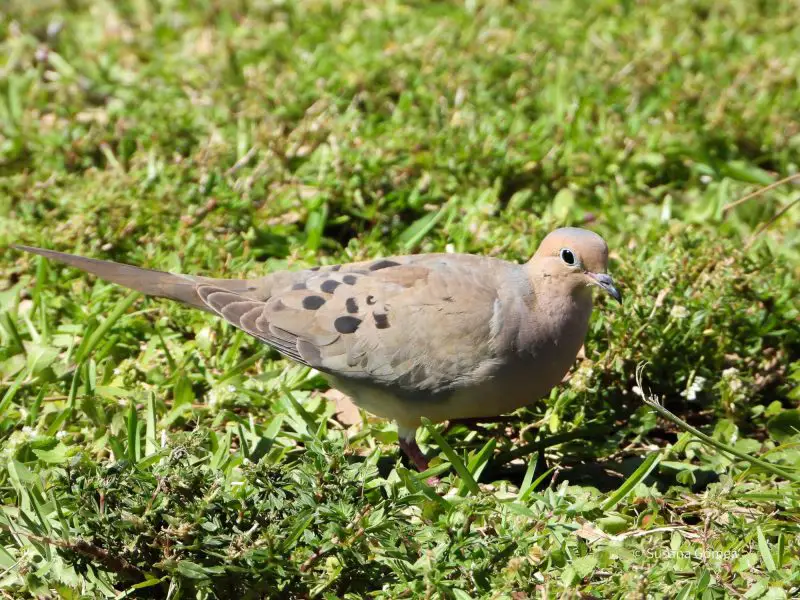
The Mourning Dove is a sleek, slender dove with soft gray-brown plumage, black spots on the wings, and a long, pointed tail edged in white. It measures around 9 to 13 inches in length and has a small head, dark eyes, and a gentle, streamlined appearance.
These doves are known for their soft, mournful cooing call, which gives them their name. Their flight is swift and direct, with sharp wing whistles when taking off. Mourning Doves often feed on the ground, foraging for seeds in open fields, yards, and along roadsides.
In Mississippi, Mourning Doves are abundant and widespread year-round. They are common in both rural and urban areas, nesting in trees, shrubs, or even on balconies. Their adaptability and peaceful presence make them familiar birds across the state.
Rock Pigeon (Columba livia)
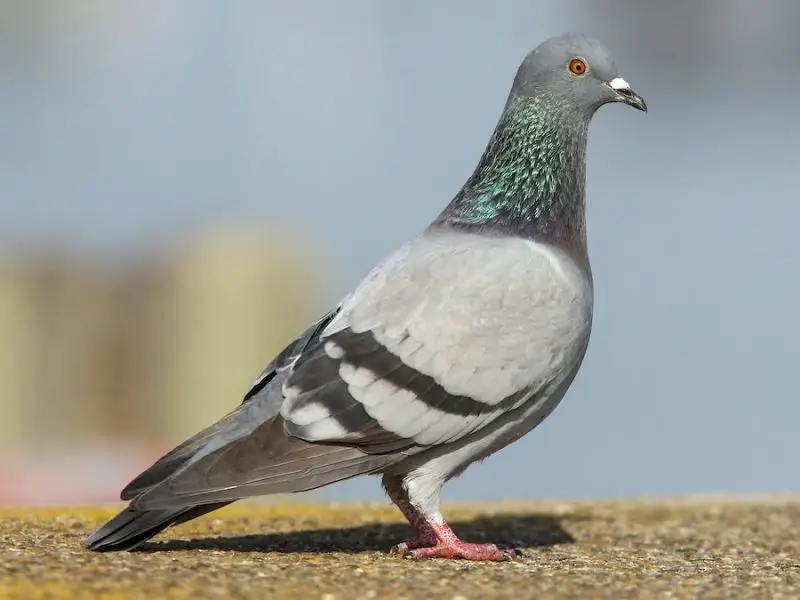
The Rock Pigeon is a stout bird with a wide range of plumage colors, though most commonly it appears gray with two dark wing bars and an iridescent green and purple neck. It measures about 11 to 13 inches in length and has a rounded body with a short neck and small head.
These birds are highly social and often found in large flocks in urban areas. They walk with a head-bobbing motion and feed mostly on grains, crumbs, and scattered seeds. Rock Pigeons are excellent fliers and were once used as homing birds for messages due to their navigation skills.
In Mississippi, Rock Pigeons are primarily associated with cities, towns, bridges, barns, and other structures. They nest on building ledges, under eaves, or in old barns. As non-native birds, they are present year-round and have adapted well to human-altered environments.
Eurasian Collared-Dove (Streptopelia decaocto)
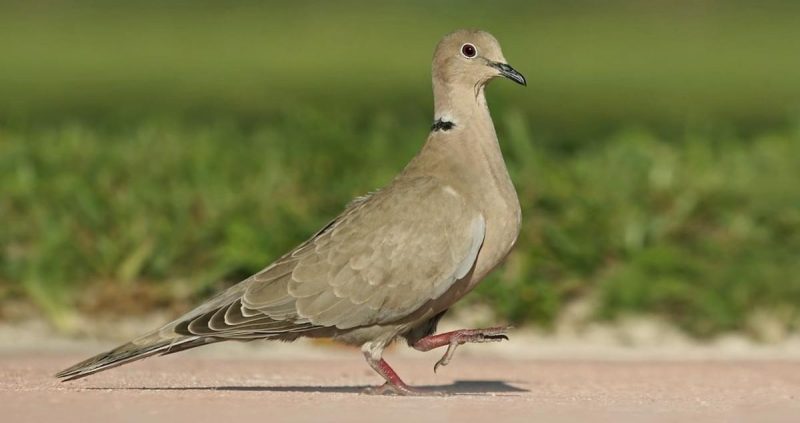
The Eurasian Collared-Dove is a pale gray bird with a slender body, a squared tail, and a distinct black half-collar on the back of its neck. It has red eyes and a gentle expression, with slightly pinkish hues on the breast. This dove is slightly larger than the native Mourning Dove, measuring about 12 to 13 inches long.
Its cooing call is three-parted and more rhythmic than that of the Mourning Dove. Eurasian Collared-Doves are often seen walking calmly on the ground or perched on wires and rooftops. They are highly adaptable and often nest in trees, ledges, or even on outdoor structures like sheds.
In Mississippi, this species has expanded rapidly over the last two decades. It is now common around farms, grain elevators, suburban neighborhoods, and small towns. These doves thrive in open areas with scattered trees and easy access to food.
American Kestrel (Falco sparverius)
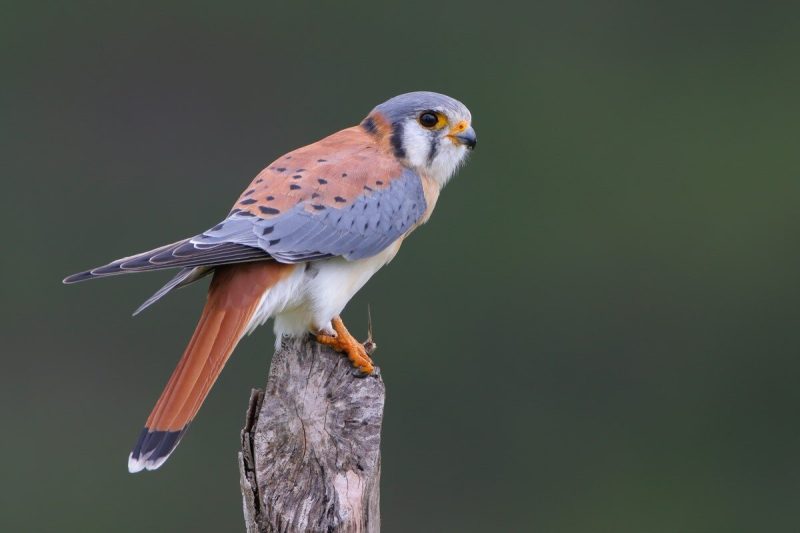
The female American Kestrel, the smallest falcon in North America, often appears grayish overall with rusty streaks on the belly and back. Her head features a pale face with two bold vertical black stripes and a lighter crown. She measures about 8 to 11 inches long with pointed wings and a square-tipped tail.
Female kestrels are less brightly colored than males and tend to perch quietly on power lines, fence posts, or dead tree limbs. From these perches, they watch for grasshoppers, small rodents, and other prey, hovering in place when preparing to strike.
In Mississippi, American Kestrels are most often seen in open fields, grasslands, and along rural highways. They are present year-round in some parts of the state but more visible in fall and winter. Females are especially common in farmland habitats.
Red-tailed Hawk (Buteo jamaicensis)
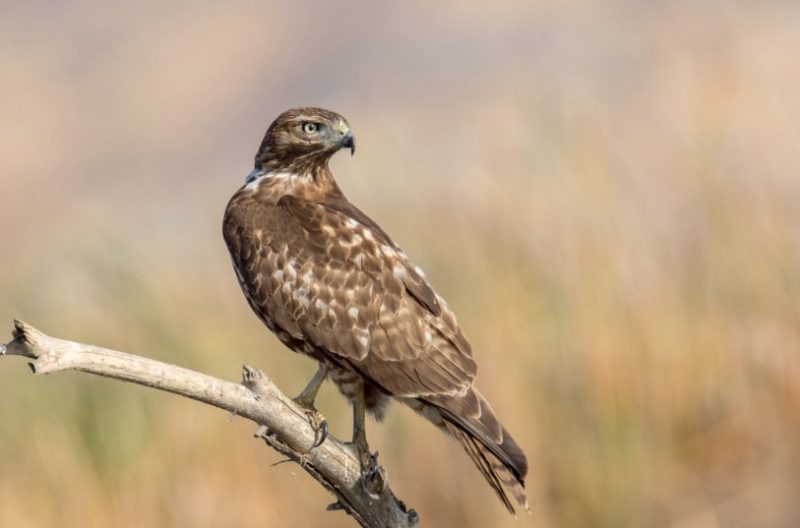
Juvenile Red-tailed Hawks typically have grayish-brown plumage with streaked underparts and a finely barred tail that lacks the distinctive red coloration of adults. Their wings are broad, and they have a slightly hunched posture when perched. These young birds measure between 18 and 22 inches long with an impressive wingspan.
They are skilled hunters and often soar in wide circles above fields or woodlands, using their keen eyesight to locate prey. From a distance, they may be mistaken for other hawks due to their variable plumage. Their scream, a high-pitched descending whistle, is iconic in movies and often used as a generic “raptor sound.”
Juvenile Red-tailed Hawks are a familiar sight in Mississippi throughout the year. They are most often seen perched along highways or soaring above open country. They inhabit nearly every type of habitat, from forests and farmland to city outskirts.
Northern Parula (Setophaga americana)
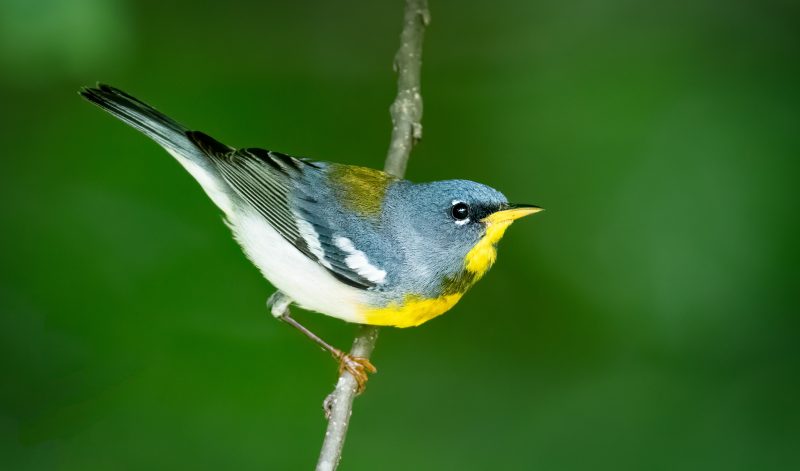
Female or immature Northern Parulas can appear dull grayish with only faint hints of the bright colors that define the adult males. They are small, active warblers, measuring just 4.3 to 4.7 inches long, with short tails and slender, pointed bills. Their upperparts are generally bluish-gray, while the underparts may show a wash of yellow or white.
These birds are quick and energetic, constantly flitting through high branches in search of small insects and spiders. Unlike males, the females and immatures lack the bold chest band and vivid throat coloring, making them harder to spot among foliage.
In Mississippi, Northern Parulas breed in moist forests, especially where Spanish moss or old man’s beard lichen is present. They are often found in bottomland hardwood forests, cypress swamps, and along wooded rivers during spring and summer.
Eastern Kingbird (Tyrannus tyrannus)
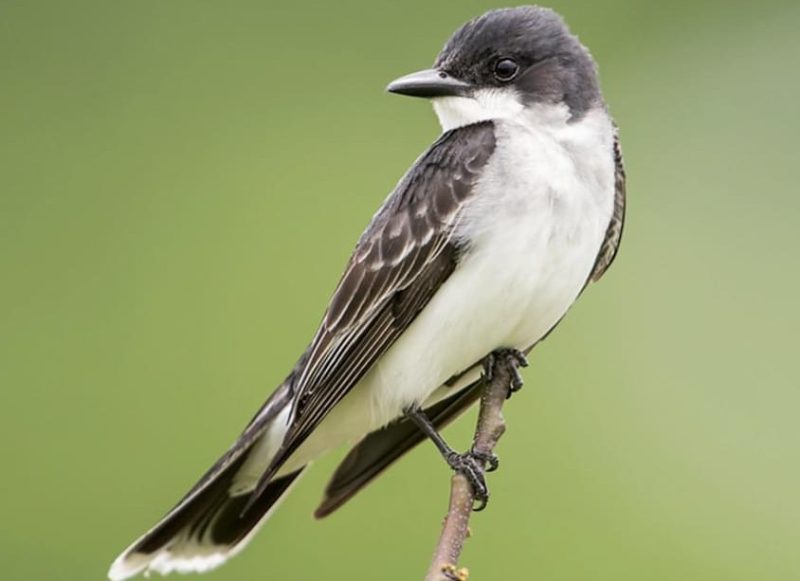
The Eastern Kingbird is a striking bird with dark gray to blackish upperparts, white underparts, and a noticeable white band at the tip of its tail. It has a sturdy build, a square tail, and a sharp, slightly notched bill. Adults measure about 7.5 to 9 inches in length.
This species is bold and aggressive, often seen chasing away much larger birds from its nesting territory. Eastern Kingbirds are flycatchers and feed by sallying out from perches to catch flying insects in midair. Their call is a rapid series of sharp notes often given in flight.
In Mississippi, Eastern Kingbirds are common summer visitors to open fields, orchards, roadsides, and forest edges. They frequently perch on fences or wires and build their nests in shrubs or low trees, often near water or open pastures.
Great Crested Flycatcher (Myiarchus crinitus)
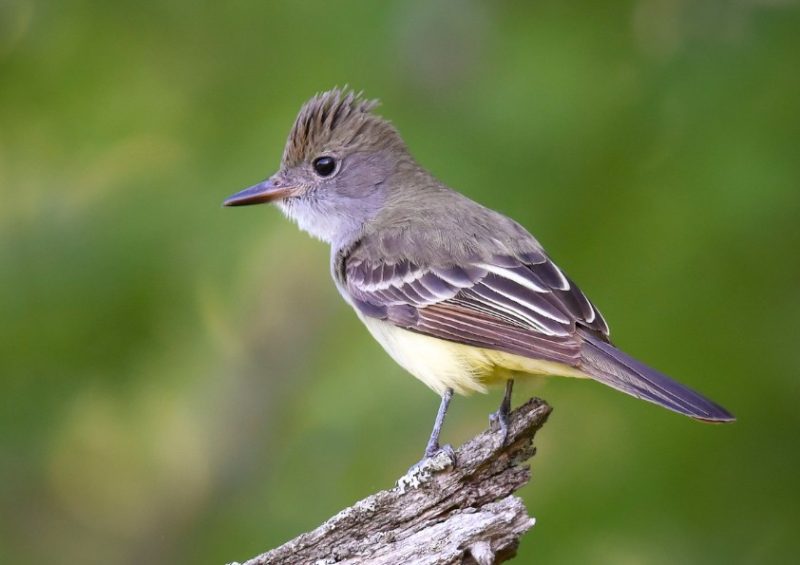
Juvenile Great Crested Flycatchers often show a more muted, grayish overall plumage compared to the bright yellow and rusty tones of adults. They have a crest on their heads that can appear less pronounced, and their underparts may look paler. These birds measure about 7.5 to 9 inches in length with a sturdy build.
Young flycatchers are active foragers, frequently sallying out from perches to catch flying insects. Their calls include sharp “wheep” or “breep” sounds, and juveniles may practice these vocalizations as they mature. They are shy and tend to stay near dense trees.
In Mississippi, juveniles inhabit forest edges, tall trees, and wooded suburbs during the summer breeding season. They prefer mixed or deciduous forests with plenty of open spaces for hunting insects.
Black-capped Chickadee (Poecile atricapillus)
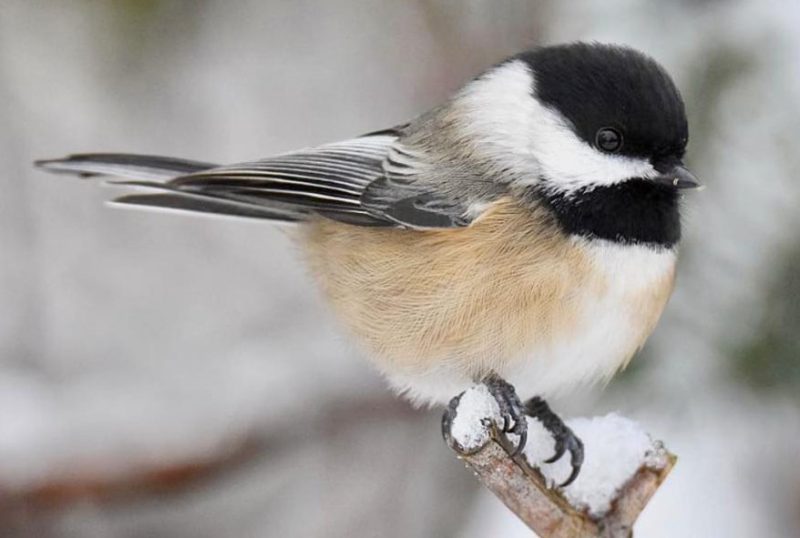
The Black-capped Chickadee is a small, round songbird with a distinctive black cap and bib contrasted against pale gray sides and white cheeks. It measures about 4.7 to 5.5 inches long. This species is more common in northern regions but only rarely visits northern Mississippi during harsh winters.
Black-capped Chickadees are curious and bold, often approaching feeders. Their characteristic “chick-a-dee-dee-dee” call varies in intensity depending on context. They are active year-round, flitting among branches and hanging upside down while searching for insects and seeds.
In Mississippi, these birds are occasional winter visitors in the northernmost counties. They prefer mature forests with mixed hardwoods and conifers and are usually seen in small flocks during the colder months.
Dark-eyed Junco (Junco hyemalis)
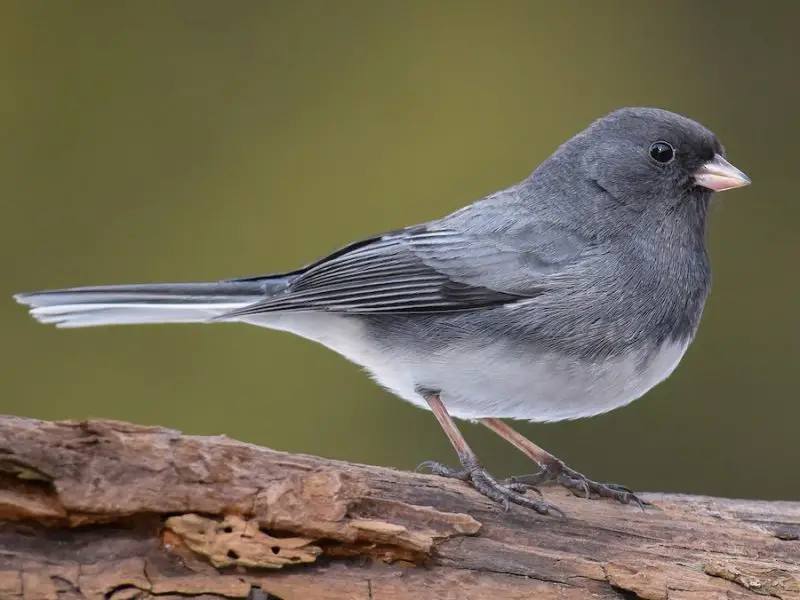
The Dark-eyed Junco is a small sparrow with a slate-gray body, white belly, and a pale pink bill. It measures approximately 5 to 6 inches in length. This slate-colored form is the most widespread and familiar during the winter season across much of the United States, including Mississippi.
Juncos are ground foragers, often seen hopping through leaf litter and open fields searching for seeds and small insects. Their flight is low and direct, and their soft, musical trill is heard during short flights or as a contact call.
During winter in Mississippi, Dark-eyed Juncos inhabit woodlands, suburban yards, parks, and open fields. They often join mixed-species flocks and are a welcome sign of the cooler months.
Pine Warbler (Setophaga pinus)
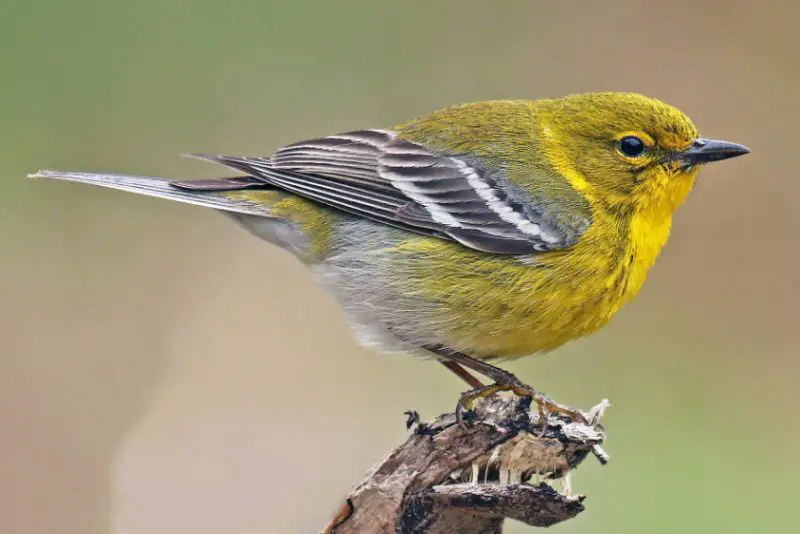
Outside the breeding season, Pine Warblers display a duller grayish-green plumage compared to their vibrant yellow breeding colors. They are medium-small songbirds, about 4.5 to 5 inches long, with a relatively thick bill adapted for foraging pine seeds and insects.
These warblers are often seen clinging to pine tree trunks and branches as they search for food. Their song is a simple trill or buzz that carries through the forest. Non-breeding individuals may travel in small flocks and are less territorial than during spring.
In Mississippi, Pine Warblers can be found year-round in pine forests and mixed woodlands. They are more secretive outside the breeding season but remain faithful to coniferous habitats across the state.
Yellow-rumped Warbler (Setophaga coronata)
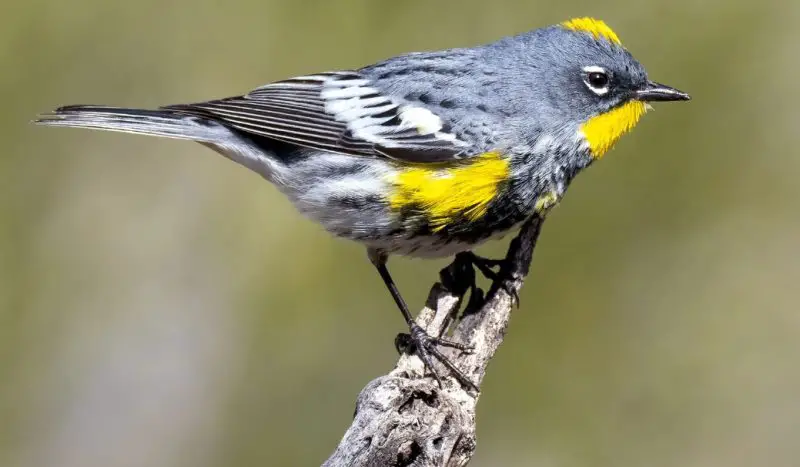
During winter, Yellow-rumped Warblers have mostly gray plumage with dull yellow patches on the rump, sides, and sometimes the throat. They are small, active birds about 5 to 6 inches long, with sharp bills used for gleaning insects and eating berries.
These warblers forage actively in shrubs, trees, and forest edges, often moving quickly while flicking their wings. In winter, they supplement their diet with berries and fruits, which allows them to survive colder months.
In Mississippi, Yellow-rumped Warblers are common winter visitors, frequenting wooded areas, brushy thickets, and suburban yards. Their presence signals the seasonal change, and they often join mixed flocks of other insectivorous birds.
FAQ About Gray Birds in Mississippi
What are some common gray birds found in Mississippi?
Mississippi is home to many gray birds such as the Northern Mockingbird, Tufted Titmouse, Gray Catbird, and Blue-gray Gnatcatcher. These species vary in size and habitat preferences but are commonly spotted throughout the state.
How can I identify gray birds in Mississippi?
Look for key features like size, wing and tail markings, beak shape, and behaviors. For example, the Northern Mockingbird has bold white wing patches, while the Gray Catbird has a distinctive black cap and reddish undertail.
When is the best time to see gray birds in Mississippi?
Many gray birds are year-round residents, so you can see them anytime. However, some, like the Blue-gray Gnatcatcher and Yellow-rumped Warbler, are more common during spring and summer or in winter months respectively.
Where do gray birds typically live in Mississippi?
Gray birds inhabit various environments including urban parks, woodlands, forest edges, wetlands, and open fields. For instance, the Loggerhead Shrike prefers open farmland, while the Eastern Phoebe is often near wooded streams and bridges.
Are gray birds in Mississippi migratory or resident?
It depends on the species. Some gray birds, such as the Northern Mockingbird and Tufted Titmouse, are permanent residents, while others like the Yellow-rumped Warbler and Dark-eyed Junco are seasonal migrants.
How can I attract gray birds to my backyard in Mississippi?
Providing native plants, shrubs, bird feeders with seeds or suet, fresh water, and safe nesting spots can attract many gray bird species. Offering a mix of seed types and maintaining diverse vegetation helps meet their feeding and shelter needs.


